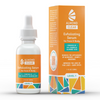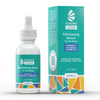What Causes Butt Acne?
A customer recently emailed Almond Clear with the following question:
“ I don’t understand why I have butt acne. The rest of my body and face are totally clear, but my butt is a disaster. I get regular, horrible butt breakouts, and sometimes they even turn into painful cysts. Can you please explain what causes butt acne?”
To answer this question, first we need to review why acne occurs on the skin in general. Then we can look at what about the butt in particular makes it more prone to breakouts.
An Acne Overview
- You are constantly forming new skin cells to replace the old ones that die off and are shed on the surface of your skin. Inside your pores, dead skin cells are also sloughed off at a regular pace. However, inside the pores of acne-prone people, skin cells are produced and shed very quickly. This results in a buildup of dead skin cells. Key takeaway: Acne-prone people shed dead skin cells very quickly.
- This excess dead skin mixes with the body’s natural sebum, or oil, inside the pores, and a plug is formed. As more skin cells and oil collect in the pore, the plug gets bigger and bigger. The technical term for this is “retention hyperkeratosis,” and this is what’s behind acne. Key takeaway: Acne is caused by lots of dead skin cells that mix with oil and clog the pores.
- When bacteria invade the pore and feed off of the sludge of dead skin cells and oil, the pore becomes inflamed. Eventually, as more bacteria builds up, the walls of the pore explode, and the surrounding skin becomes contaminated with an irritating mix of bacteria, skin cells, and oil. The body pumps white blood cells into the area to fight the infection, which creates pus, and a large, red, raised bump is formed. These nodules or cysts can be painful and often leave scars behind. Key takeaway: Bacteria does not cause acne, but it does cause it to become painful, red, and enlarged.
- The overall, big takeaway: Adult with blemishes have an inherited tendency to produce dead skin cells too quickly (called retention hyperkeratosis), which results in clogged pores. Clogged pores create an ideal environment for irritating bacteria to fester. To treat this problem, you need to stop dead skin and oil from building up.
What Causes Butt Acne?
- As discussed above, the main culprit for all types of acne is retention hyperkeratosis. It’s likely that people who suffer from butt acne tend to shed skin cells particularly quickly on their buttocks area. In addition:
- The skin on your butt spends most of its time constricted under clothing and underwear, and even worse, many people spend hours sitting on their rear ends every day. This creates an environment in which bacteria, dirt, and sweat are trapped against the skin, and these are the ingredients that cause breakouts to flare up.
- Your butt is subject to a lot of friction. Your butt cheeks rub against each other and against your legs. The seam lines of underwear rub against your skin. When you sit, your butt rubs against the surface of the chair. Acne mechanica is a type of acne that’s made worse by repeated rubbing and friction that irritates the skin. Have you ever broken out on your shoulders from carrying a purse or backpack too often? That's a perfect example of acne mechanica. This type of acne also occurs on the butt because of all the friction and rubbing that it’s subjected to.
- Wearing sweaty workout clothes contributes to butt breakouts. In a warm, sweaty environment, bacteria spread more easily, causing acne to get much worse. It’s very important to change out of sweaty clothes immediately after exercising.
- Tight clothing and non-breathable, synthetic fabrics can also contribute to acne because they don’t allow your skin to breathe. Make sure to wear breathable clothing and underwear, and wear natural, breathable fibers like cotton.
How Can I Get Rid of Butt Acne?
To clear butt blemishes, it’s most important to regularly apply a skin care product that clears retention hyperkeratosis and that fights bacterial growth. Alpha and beta- hydroxy acids like glycolic, salicylic, and mandelic acids are strongly exfoliating (meaning that they remove dead skin cells and oil) and are also anti-bacterial. All of these acids are good options, but mandelic acid is an especially smart choice because it's also naturally anti-fungal, so it's ideal for people who suffer from a combination of acne and fungal folliculitis (these related problems are commonly found together on the buttocks). Whatever skincare acid you choose, it's crucial to apply twice-daily because that ensures that no new plugs are able to form in the pores.
When you apply the product, make sure to cover the entire area where you get blemishes. Many people spot-treat blemishes, meaning that they only apply the product to active pimples. This might help to clear up those pimples more quickly, but spot-treating doesn't prevent new breakouts from happening. If you want to clear up your skin for good and stop new pimples, then it's crucially important to apply the product to the entire problem area.
In addition to applying a topical treatment, be sure to change out your sweaty gym clothes quickly, wear breathable clothing and underwear, and try to maintain a healthy lifestyle. By following these tips and using the right treatment products, you should be able to say goodbye to booty breakouts for good!








